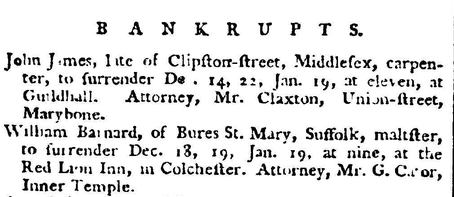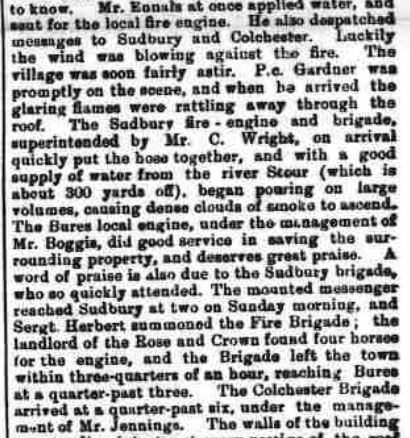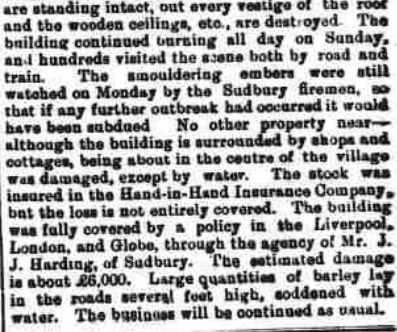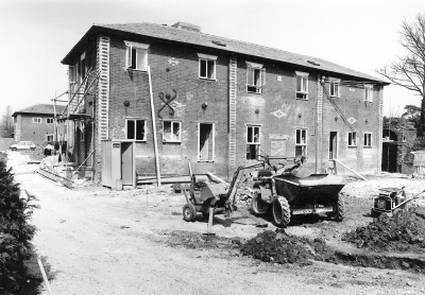 |
Taken from "The Times"
newspaper dated December 1787.
My research does not go back as far
as the 1700`s, but this does confirm that a Maltings was active
in the village, albeit not very successful for Mr Barnard.
|
Malting in Bures was an
important industry in the 19th century. No less than six maltings produced
ten tons of malt per day to supply local pubs ( which supplied their own
beer) breweries and even the export trade to the continent via Colchester
ports.
(source Suffolk County Council)
There are known to have been six malt houses
in the parish, the three oldest of them in the High Street which were
producing malt up until 1939. There was the malt house in Church Square
where it joins Nayland Road, now replaced by the disused textile factory
on its site, and across the bridge in Bures Hamlet close by the river
was the 1836 malt house put up by John Garrad who also put up the larger
1851 malt house beside the railway line. John Garrad was also a proprietor
by this time of the three malt houses put up around 1750 in the High Street.
(Source Dr Brown)
Description of the Building
(source ECC)
Mid-19th century malthouse, the building
has a ‘H’ shape plan with 2 storey crosswings and a 3 storey,
15 bay central range.
Built of red brick with yellow brick pilasters and a Welsh slate roof;
the crosswings have taking-in doors on both floors of the west elevation.
The slate covered pyramidal kiln lies at the south end of the central
range.
A stone on the south face of the south wing is dated 1851, but some of
the tie plates carry the inscription ‘Nicklin and Harford Birmingham
1824’; the latter may have been reused.
Additional doors and windows have been inserted as part of the conversion.
The steeping pit lay at the north end of the building and could hold 4
tons of barley in 2500 gallons of water.
After five days on the drying floors the barley was taken to the kiln;
access was provided by a door at second floor level and the barley was
lifted from the lower floors by bucket elevators.
The drying floors were supported on slender cast iron columns and the
kiln had a wedge wire floor. Malt could be stored in the south wing.
|

Bury and Norwich Post
February 11th 1890
>>>>>>
These maltings are not those by the Railway
as it quotes a "Mr Pratt nearby ajoins"
Mr Pratt is listed as a Grocer in 1892 in the High Street
|


 Framlingham Weekly News February 15th
1890
Framlingham Weekly News February 15th
1890 |
History of Maltings
pre 1900
The Maltings was the most important non--agricultural source of work in
Bures. This one was built in 1851, two years after the railway opened.
The Garrad family were the owners. The block at the left end had doors
where the barley grain went in, carried up 10-12 steps on cat-ladders
in 16 stone sacks and also a large tank for soaking. The Maltings had
low ceilinged floors where the grain was turned over with metal ploughs
as it sprouted. Small louvered windows controlled the critical temperature
needed for the malting process. A beehive shaped kiln dried the barley
with a chute to the right where the barley came out. Bures maltsters finished
work about March/April when the barley was finished and switched to the
land, local builders or the mill for the summer months returning in September
at harvest time.
Kelly`s Directory recorded
these Maltsters in Bures Hamlet:-
Garrad 1844 (recorded as Maltster before
the Maltings was built in 1851)
Garrad and Grimston Partnership 1868
Walter Edward Grimston 1874, 1884, 1887, 1890, 1892, 1895, 1899,
1900, 1902, 1906.
Cross and Garrad 1910 1912 1917 1925
1929
Garrad 1937
Trumans:- start date unknown
Originally the Maltings
were owned by the Garrad family, but the majority of the malt produced
was purchased by Truman, Hanbury & Buxton. Trumans had a vast 6 acre
brewery complex in London.
In 1868 Garrad went into
partnership with Walter Grimston (Garrad and Grimston Brewery) which proved
very successful.
 |
By 1899 Grimston owned 16 pubs
in the Colchester area which were all purchased by Trumans. Grimston
was the local Justice of the Peace, perhaps he considered that his
service to the community was incompatible with his ownership of
public houses where maybe, so many of his customers might have been
brought before him in the dock!
Grimston still owned the Maltings some 40 years later until approx
1910.
<<<<Writing on wooden
plank between workers states:-
"GRIMSTON OF BURES"
|
Soon after 1937, Garrad
handed over control of the Bures Maltings to Trumans.
No brewing or bottling was
ever carried out at Bures, the majority of the malt was transported to
the Brick Lane, London depot of Trumans for processing.
Locally there was also the Daniells Brewery (1830>) at West Bergholt
who were finally taken over
by Truman Hanbury in 1958.
Some malt may well have finished up going to Bergholt. In its latter years
it was only used as a bottling plant.
|
|
Truman`s eventually
ceased all production at Bures on August 22nd 1980.
After all the equipment was removed the doors finally shut on July
10th 1981. |
The two other Maltings
at Sudbury and Long Melford closed shortly afterwards in 1985/6
 |
Circa 1983/84, conversion
to residential property |
|
Mid-19th century
malthouse converted to residential use in 1984.
The conversion retains the features of the original building with
its H’
shape plan and 2 storey crosswings. Built of red brick with yellow
brick pilasters and a Welsh slate roof; the crosswings have taking-in
doors on both floors of the west elevation. The slate covered pyramidal
kiln lies at the south end of the central range. A stone on the
south face of the south wing is dated 1851, but some of the tie
plates carry the inscription ‘Nicklin & Harford Birmingham
1824’; the latter may have been reused.
Additional doors and windows have been inserted as part of the conversion.
|
|
|
2003:- The maltings
tower can still be clearly seen behind the main building. |
Updated
29/05/2015
updated 23/02/2017 Newspaper Cuttings
|
